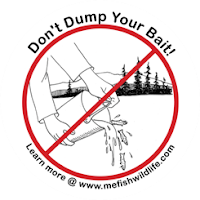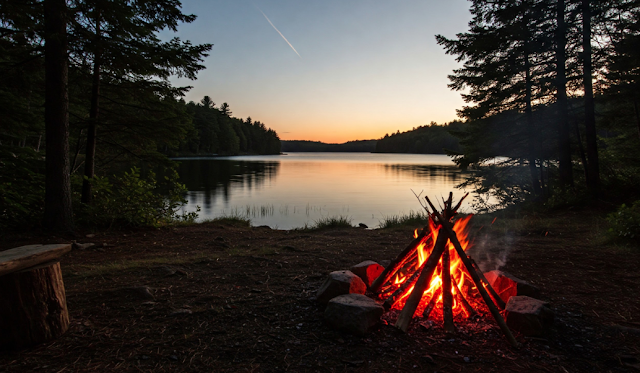Maine lakes are popular summer destinations for vacations and offer fantastic opportunities for swimming, boating, fishing, hiking, and just relaxing on the shore. All who enjoy this extraordinary and fragile ecosystem must participate in keeping it healthy. Every effort to help is meaningful, especially when multiplied by thousands of visitors and property owners.
This page provides important information for visitors and homeowners to ensure that your time spent on a Maine lake is safe and environmentally sound.
Taking your phone?
You may be surprised at how many phones lie at the bottom of Maine lakes!Use a floating waterproof case for phones and cameras.
Maine laws
Click here for Boating, Fishing, and ATV rules at the Maine Inland Fisheries and Wildlife.
Going Boating?
Safe boating is good for people, wildlife, and the ecosystem! You can take the free Maine boaters safety course presented by the Maine Lakes Association at https://mainelakes.org/education/boater-ed/Important boating rules
- Boats need a Maine Lake and River Protection Sticker, even if your motorized craft is registered out of state. (Up to $500 fine for failing to affix the sticker to your motorized craft, including a seaplane).
- A person born on or after January 1, 1999, may not operate a motorboat greater than twenty-five (25) horsepower for recreational boating purposes on inland waters of this State or territorial waters, unless that person is 12 years of age or older and has completed a boater safety and education course
- A person born after January 1, 1999 is also required to complete a boater safety and education course and be at least 16 years of age to operate a personal watercraft (Jet ski) or to supervise a person under 12 years of age who is operating a motorboat.
- There is a 200 foot (66 yards) Safety Zone along all shorelines on all Maine Lakes. The Safety Zone is defined as a swimming area. Within this safety zone, only headway speed is allowed, unless picking up and dropping off a skier. Headway speed means the slowest speed at which the craft can be steered.
The purpose of the safety zone is to prevent you hitting rocks, wildlife, or a person swimming, as well as preventing erosion of the shoreline, or damaging docks and other boats with boat wake. - Wake boats may only be operated in waters deeper than 15 feet and only more than 300 feet from any shoreline.
Loons
The Common Loon is an iconic and majestic bird and seeing them on a lake is a memorable experience for us, but it is often not very pleasant for them.
A loon vocalizing at you or splashing across the water is a sign they are stressed and you are too close to them. Boat wake and other human interaction can drive off nesting loons permanently, so keep you distance and enjoy them quietly through binoculars.
See How Close is Too Close? to learn how to tell when a loon is relaxed, concerned or stressed.
Bird Nests
You may be lucky enough to notice a Bald Eagle, Osprey, or a waterfowl nest. Do not disturb any nesting birds. Do not approach, throw things, yell, shout, etc. to 'make them fly' - most species will abandon their entire breeding attempt if their nesting area is disturbed.
Invasive plants
Numerous Maine lakes have invasive aquatic plants and present a major threat to other lakes. These plants can spread quickly and infest an entire lake from a small fragment or seed. Invasive plants (and other organisms) spread when carried on motors, fishing gear, anchor lines, live wells, and trailers and can survive out of water for a long time.
- Avoid boating in areas of dense plants.
- Check your boat/kayak/canoe, trailer, gear and anchor lines thoroughly before and after visiting any lake - It’s the law, and you can be fined up to $2500 for transporting any aquatic plant.
- Dispose of all plant fragments in trash receptacles on high, dry land.
- Clean, drain (not on the boat ramp!), and dry all equipment that has been in the lake. By law boaters have to take specific actions to encourage water to drain from their watercraft prior to entering a water body or leaving a launch site.
Some boat launches have Courtesy Boat Inspectors who can inspect your boat for invasives before and after launches. They can help you avoid a fine and help prevent an invasive plant from getting to a new lake.See https://www.maine.gov/ifw/fish-wildlife/fisheries/aquatic-invasive-species.html
Going Fishing?
- Go lead-free! Lead that enters our lakes as lost or discarded fishing gear is a leading cause of death for adult Common Loons.
- Do not dump bait into the lake - it’s illegal, can disrupt food chains and introduce disease.
- Always carry out fishing line, lures, and litter. Your bait tub goes home with you.
- Avoid casting too close to overhanging trees and other snags. If you do get your line caught up, ensure that you do the responsible thing and cut it all off. Fishing line entangles birds.
Maine fishing laws: https://www.maine.gov/IFW/fishing-boating/fishing/laws-rules/index.html
For Fishing & Harvesting Baitfish and Smelt see: https://www.maine.gov/ifw/fish-wildlife/fisheries/aquatic-invasive-species.html#fishing
On shore...
The land within 100 feet of the lake is the “buffer zone” and should be treated with extra care! It is an important part of the lakes’ ecosystem. Avoid clearing leaves, pine needle duff and other ground cover. Cutting trees in the buffer zone is tightly regulated.
Kick back, slow down, and relax!
We’re glad you’re here! Enjoy the beauty and serenity that Maine lakes have to offer.
Look after it so it will be there the next time you or your children choose to visit.
Some images AI generated.







